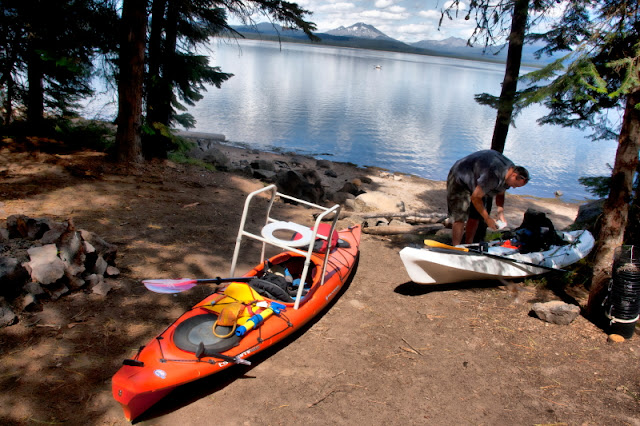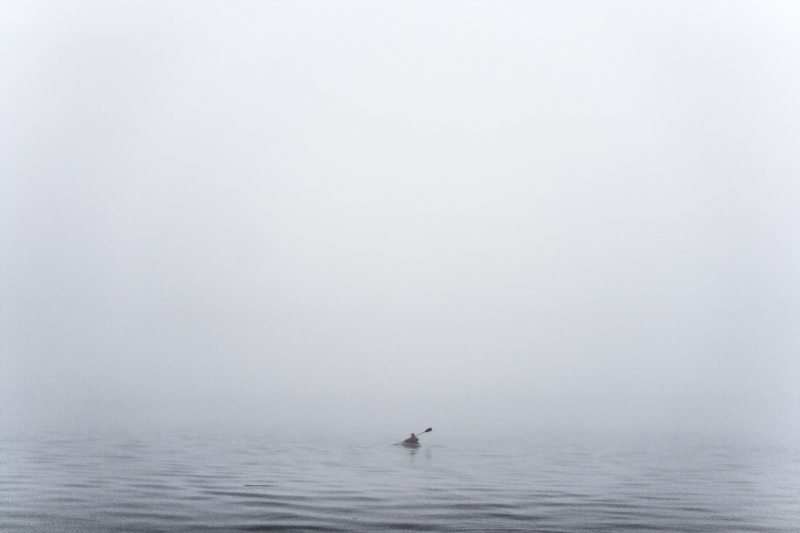If you can block a stream,
and keep the water from getting away, you can bury an existing prairie and make
your own lake and use it to stock trout for sport and water for irrigation.
That's what human beings did in 1922 to the Deschutes River Prairie (thank you
Wikipedia). Beavers have a knack for doing this kind of thing without
(presumably) thinking about it very much. Humans are learning to think about it
with greater sensitivity, now that it is becoming clear that resources and land
are limited, but regardless, the big winner here may very well be mosquitoes.
 |
View from campsite #1. Left
to right: North Sister (behind South Sister), South Sister, Broken Top,
Bachelor & I don't know. Note: clicking on images should display a larger version.
|
Uncle Rico, Kip and I set
out for Crane Prairie Reservoir, Uncle Rico in his character laden Jeep, and
Kip and I in Kip's new normal passenger vehicle, destined to acquire some
character of its own. My vehicle has accumulated enough character to become
taciturn and devious toward humans and so we left it parked safely at Kip's.
At some point, I must have
made a disparaging remark about Uncle Rico's aqua-pod, because when I had
finished setting up my tent and turned my attention towards launching my kayak,
I was able to decipher the subtle opinion Uncle Rico held for my trusty
Tsunami.
Much of the reservoir
appears to be shallow, and as fate would have it, locating the best fishing
spots seemed tightly correlated to distance - that is, the further away from
our campsite, the better the fishing. On a reservoir of approximately 5 square
miles (thanks spam-like web page) this unhappy correlation became significant.
 |
This osprey quickly grew irritated with me - as if it thought I might try to steal its
supper - and scolded me soundly before flying off
|
Besides mosquitoes (really
they weren't that bad), osprey and eagle seemed particularly appreciative of
human tinkering. Camping in the vicinity of an eagle couple, we soon became
very familiar with their domestic arguments regarding home ownership and shared
responsibilities.
Like a mythical chimera -
half boat, half man - Uncle Rico relentlessly plied the waters of the reservoir
in his quest for trout. Meanwhile, the clouds danced behind the mountains and
fought the winds to maintain coherence, using any mathematical trick at their
disposal to grow or propagate, sometimes dividing, sometimes
multiplying...sometimes toying with exponents.
...and the world turned.
By morning, the clouds had
gained the upper hand. Uncle Rico fearlessly disappeared into the void.
In camp, the moist air
highlighted silk filaments that draped the vegetation - filaments previously
not apparent in the searing light of a late summer sun - suggesting for brief
moments, that it had snowed.
I set out to experience
the void for myself. Briefly I caught a glimpse of Uncle Rico.
As the morning progressed,
the battle did not go well for the clouds.
The sun carried out an
overwhelming frontal assault, penetrating the cloud's cover.
I
think I have been here before in a dream
I wondered what Uncle Rico
sees. Does he see the return of life-giving light to the world, or is he
enraptured instead with the flicker of underwater shadows and the glint of
light on scales? I'd settle for either.
The clouds lifted until I was able to spot my landmark. Note to self: Learn how to navigate before you try this on the ocean.
Uncle Rico: Smarter than
fish.
Something about fish
expressions seem so appropriate to the horror they witness.
The forest was filled with the undertone of some indefinable buzzing at the edge of perception. We attributed this to the amazing number of yellow jackets inspecting the mud at the shoreline, but later, Kip, seeking an ideal spot to urinate, discovered a magnificently un-ideal spot to urinate.
Blobs of color speckled
the far shores and the distant vibration of motors carried across the water.
Uncle Rico's spotting scope revealed these blobs to be fishing boats.
Closer inspection of the
far side of the lake revealed a rich habitat for trout, and even I was able to
see the torpedo like shadows flee into deeper channels or hide among the fallen
snags (yet wasn't quite quick enough to photograph them).
Kip took a meditative moment to reflect on his history as a cage fighter.
Due to high fire danger,
no open or charcoal fires were allowed. Rangers came by twice, once in the
afternoon to warn us, and once in the evening when they saw smoke.
I missed the
open fire and the opportunities it affords to play, 'Will it Burn?'
A brisk wind cleaned the
sky of clouds.
Old familiar
constellations visited the reservoir...
...and much later, vain stars examined their countenances in
a looking glass lake.
On this morning, an overconfident
sun rose into a clear sky, only to be ambushed by clouds concealed low in the
valleys.
At some point in the night, a fleet of monster trucks transported a small city into the unimproved camping area next to ours. Among the many features of the small city, the most notable were the dance hall, the industrial generator, the squadron of ATVs, and a taco food cart. Miffed at not being invited to the dance hall, we broke camp.
"...pictograph...
found on boulder... of obsidian that (is) located at the southernmost member of
a 6 km-long alignment of Holocene rhyodacitic obsidian domes." (Thanks
Obsidian Lab Webpage!)
I'm beginning to suspect
that Uncle Rico's favorite part of these trips (besides the fishing) is
negotiating the forest service roads. My new yardstick for measuring the
likelihood of road pass-ability is to determine whether or not Mt. bikers are
using it for training.
We accidentally stumbled
onto a hidden lake.
...and discovered a magic
fishing hole.
















































I particularly liked the osprey pic, the mist on the mountain pics, and the time lapse of the stars.
ReplyDelete